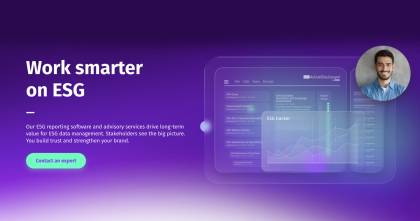Increasingly, investors want to know what your company is doing regarding the ESG issues that are most relevant to your industry. If you don't have answers, those customers will take their business elsewhere.
While your business is used to financial reporting requirements, you may not understand how to measure, analyze and report your ESG commitments. That's where ESG materiality analysis comes into play. This mapping technique not only helps your company assess ESG priorities, but prepare to report ESG commitments as part of required financial reporting.
What Is an ESG Materiality Assessment?
An ESG materiality assessment helps your company focus on the ESG issues most likely to matter within your industry, so you can plan and prioritize the impact you want to have.
As a reminder, ESG stands for environmental, social and governance. ESG has become important because it acts as a shorthand for the business's priorities, ethics, mission and vision.
Consumers have long made their purchasing decisions based on company ethics, and now investors are starting to do the same. Activist stakeholders are publicly demanding better ESG performance from companies, and reporting bodies have indicated intent to prioritize ESG moving forward.
This web of reasons means your company must quickly get up to speed regarding ESG, demonstrate your commitments, and serve the proof of your hard work through reporting.
As a tool, the ESG materiality assessment helps you cut through the noise around ESG to identify the most relevant issues, reflect on why these matter and to whom, and make the right commitments.
Done right, the ESG materiality assessment will lay the groundwork for your business to:
- Match stakeholder expectations to ESG deliverables.
- Identify ESG trends to stay ahead of the pack.
- Understand and mitigate risks in the operating environment.
- Make the case for ESG actions to stakeholders who must grant approval.
- Communicate with confidence on ESG matters.
How to Conduct an ESG Materiality Assessment
The ESG materiality assessment is critical to success with ESG initiatives. Thus, it's important to understand how it's done. A well-planned materiality assessment includes these steps:
- Identify stakeholders: List the internal and external players who are affected by your business decisions. Stakeholders include board members, employees, vendors and industry partners, and community members in the city where your business is headquartered.
- Understand what ESG issues matter most to your organization and your stakeholders: ESG is broad, and it isn't feasible to demonstrate leadership on all commitments. This step helps you prioritize what is most important to the stakeholders you just identified, so you can meet the right goals for those most engaged with your business.
- Do your homework: Choosing ESG priorities is just the beginning. After selecting the most important initiatives, do your research. Review industry standards using the SASB materiality map as a starting point. Look over ESG reporting from peers to understand commitments made by others within your industry. Reach out to stakeholders to convey your commitments and open a dialogue.
- Think about measurements: This is the point in the process where ESG materiality mapping comes into consideration. After you know what matters, why it matters and to whom it matters, it's time to think about key sustainability indicators to measure. For example, are you tracking economic indicators such as business profit, turnover or diversity of hired? Are you measuring environmental impact by tracking waste management, carbon emissions or commitment to renewable resources? If you don't reflect at this point, you may find that you've measured the wrong data when it's time to report, and you can't indicate your progress in the way you hoped.
- Review data, analyze insights and create a materiality matrix: After the data comes in, it's time to analyze and plan. If the data indicates that stakeholders value different indicators more than others, you may want to adjust your ESG commitments in accordance with their most pressing priorities. A materiality matrix is a useful tool for visualizing and working with insights. The matrix lets you graph the issues by their impact on ESG issues and their value for your business. Everyone can quickly see what is most impactful to your business and its stakeholders. When you prioritize, you can plan and act.
- Act on insights: At this point in ESG reporting, stakeholders want more than a verbal commitment. They want action. Show them you're taking it seriously by sharing the results of your survey with stakeholder in a sustainability report. Use the report as a springboard for further conversation with those most engaged. Lastly, leverage the findings for ongoing sustainability commitments. Survey data can guide internal working groups and inform internal and external communication regarding ESG priorities.
Prepare for ESG Reporting
The importance of ESG reporting will grow alongside the demand for ESG commitments.
ESG reporting is not only seen as the right thing to do, it's smart for business. Companies that voluntarily report ESG information anticipate that the matter will be pivotal for their success in the future. Accordingly, they've invested in the ESG matters that are critical to their business and want to demonstrate their achievements through reporting.
ESG reporting software such as DFIN's streamlines the workflow when it comes to capturing, analyzing and reporting ESG achievements. After you complete the materiality analysis and move toward implementation, make sure you have the right software to report and showcase your ESG commitments.

